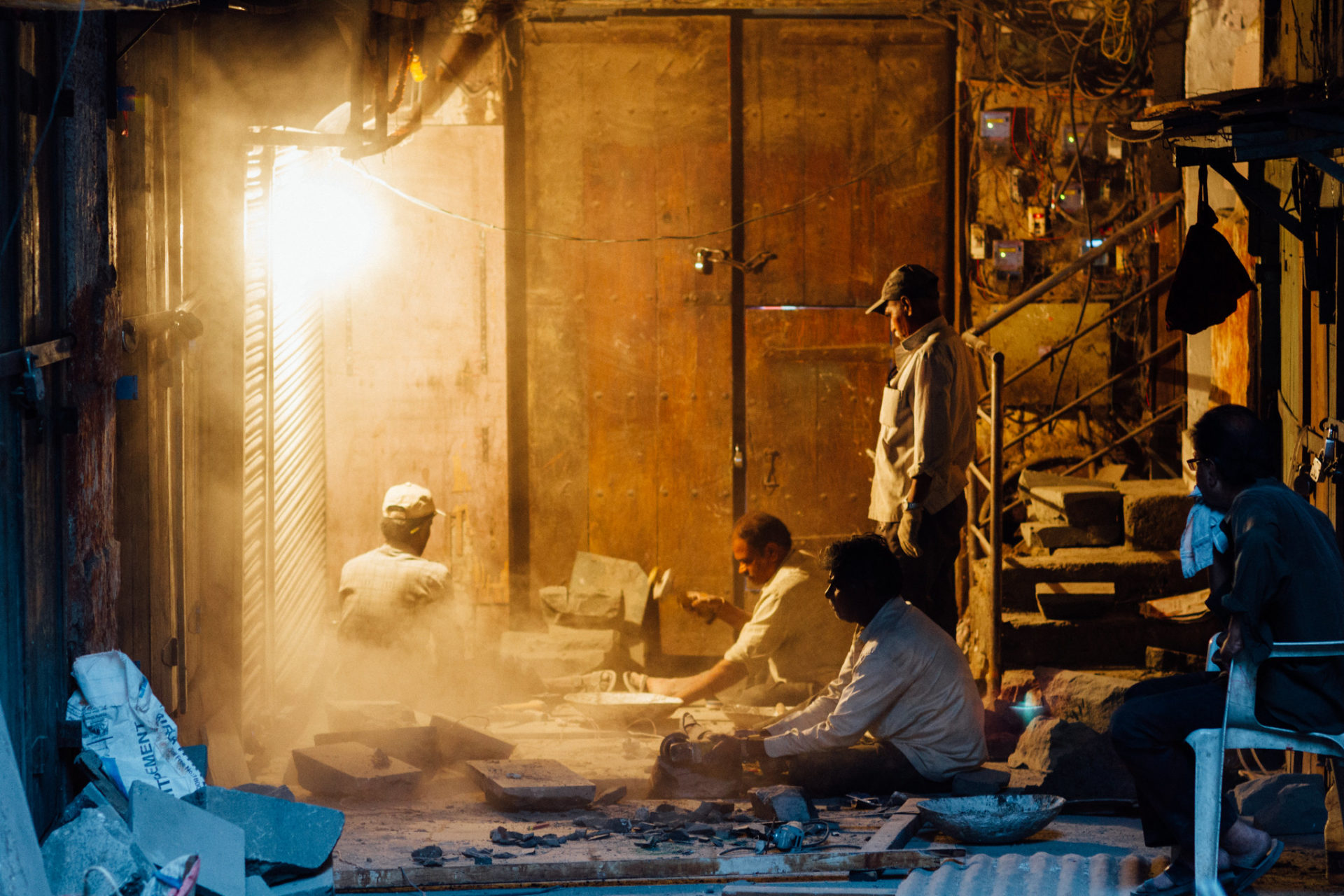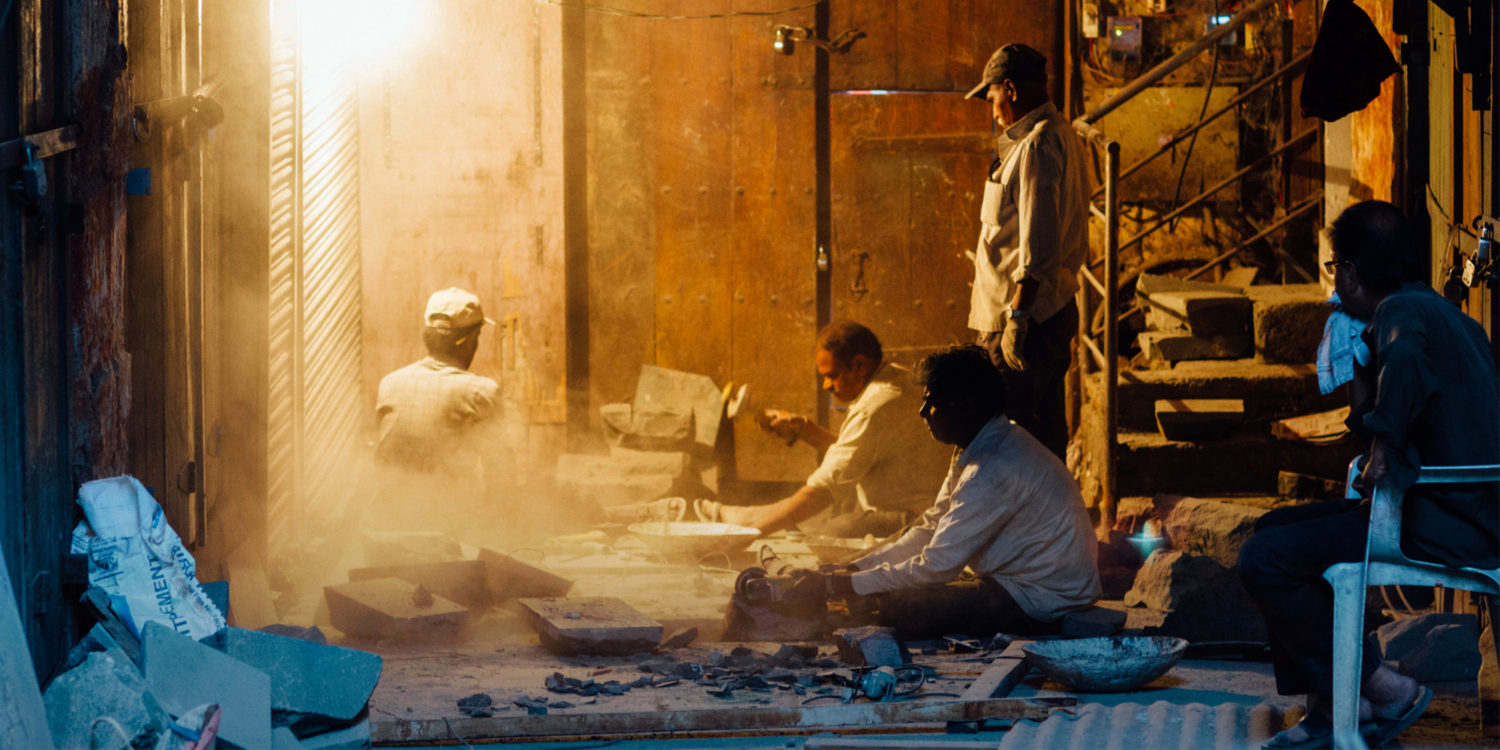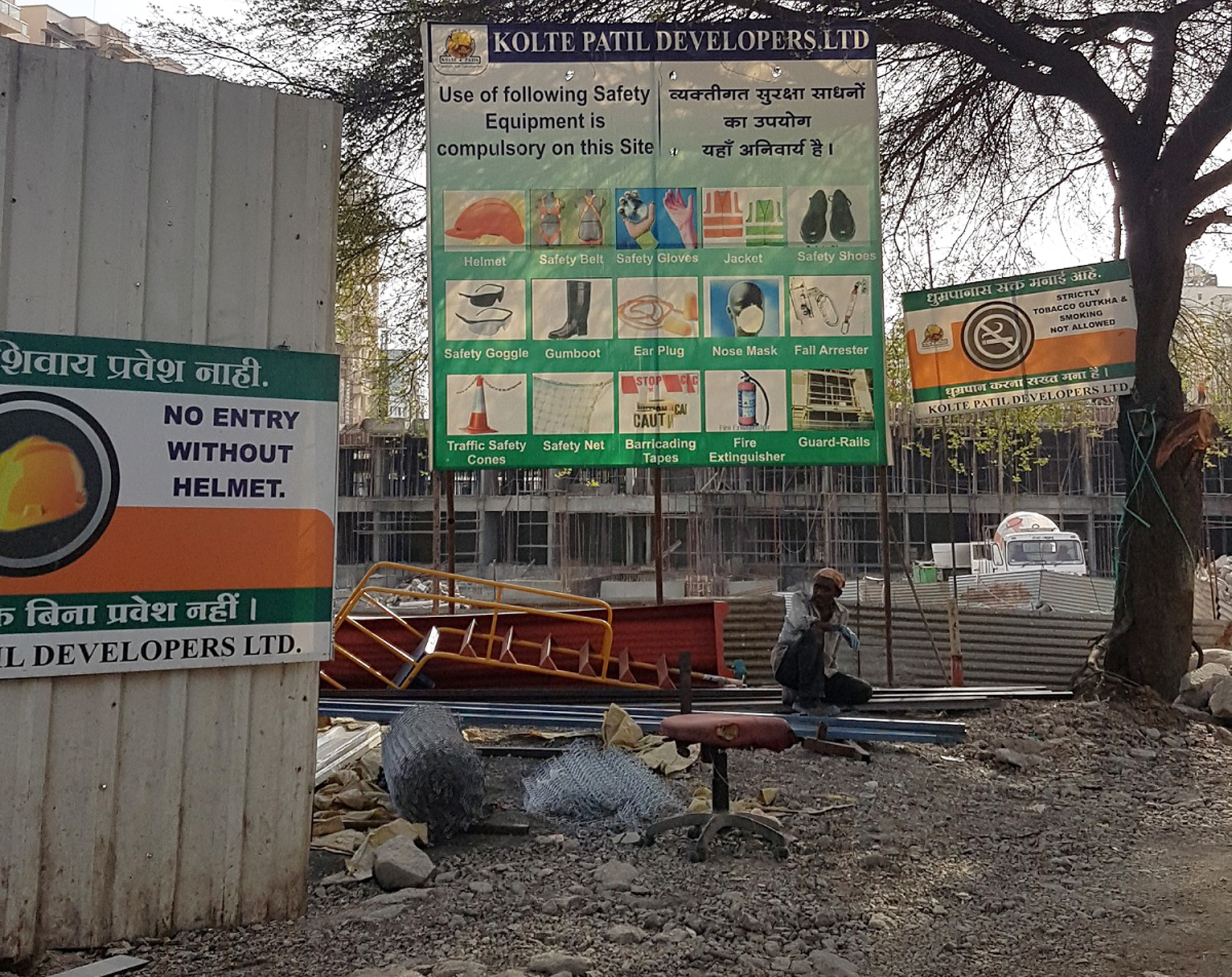This article is part of the FA special series Building Workers Unite
The Indian city of Pune contains a few downtown shopping streets that look almost as if they could be anywhere in the world. On Development Plan Road, for instance, signs of that globally-ubiquitous, smooth, accessible design abound: pretty landscaping, bike lanes, street art made from junkyard scraps and hip cafes in plentiful supply. On any given day (albeit before the lockdown) you’ll find groups of well-dressed college students sitting and chatting or having a bite to eat, owners taking their pedigree dogs for a walk and mothers tagging along on a rare outing with their car-accustomed kids. It’s the kind of scene that could easily be lifted from the pages of a developer brochure.
All the while, however, tucked away in some ignored corner of the scene, a group of labourers will invariably be busy at work digging, compacting sand, laying tiles, measuring and planting. The contrasts are stark in Pune, the second biggest city in Maharashtra state after Mumbai, and one of the 100 cities chosen for the ambitious Smart City Mission. The people who are building this smart city will probably never use it. At the end of the day, they will retire to their makeshift camps and upon completion of the project move on to another one, probably in another city with another contractor.
Big words like “sustainable”, “smart”, “tech-enabled solutions to infrastructure and services”, “citizen-friendly governance”, “mixed land use” and “walkable localities” mean very little to the thousands of migrant construction workers who fuel the industry, offering their labour in return for meagre wages and no social security. Yet the construction industry of India, and by extension its entire built environment, depends heavily on the manual labor of this large migrant workforce. Their concerns are daily wages and sending money home, as is the case with any migrant worker across the globe, and like other migrant workers, this home is a long way away, as became clear several weeks ago when hundreds of thousands of them rushed to return home as a complete lockdown was put in force by the Indian government to contain the spread of the coronavirus pandemic. Many were forced to walk several hundred kilometers after all modes of transport were suspended, while others ended up stranded without work or money.
There is a pattern to inter-state migration in the country: from the economically weaker north-west, north-east, east and north to the better off west, south-west and south. This divide is also reinforced by deeper social and regional divides, as the migrants come from distinctly different cultural backgrounds than the people in the host state. This means they’re easy targets for right wing political hooliganism: as outsiders, living in ghettos and doing work that the locals think is beneath them. These labourers also mostly belong to the lower caste and often arrive with no education, training, insurance or documents. It’s a precarious existence, where one wrong step on the site can get them killed.
Partly because of this difficult reality, these people, the ones who are actually building the country’s cities, are obscured from its heroic development story. The spectacle of smart urban development is alluring, but this toil backstage is much less glamorous, filled as it is with innumerable stories of loss, strife, loneliness and sacrifice. Even so, city dwellers need to be paying attention to these stories, because they offer the most potent reminder that India’s smart city hype is built on exploitation, itself enabled by the active invisibilisation and disconnectedness of the workforce.
When they leave their homes for the travails of city building, India’s migrant labourers get sucked into a disorganised sector where they are almost entirely at the mercy of unscrupulous contractors. There are dusty entry tax posts on the fringes of big cities like Bengaluru, New Delhi, Mumbai, Ahmedabad, Pune, where men and women, both from surrounding villages and from further afield, congregate every morning. Here, they wait to be rounded up by sub-sub-contractors who provide labour to the slightly higher in rank sub-contractor and then the contractor, the one who has the connections with city developers. Larger developers and infrastructure projects like road and bridge building usually have the same workforce with them for the duration of the project but medium and small construction projects rely heavily on these small time contractors for daily wage labor. With all this hiring done by labor contractors, smaller developers are able to wash their hands of any issues the workers may have. Women are hired for light work on-site, acting as unskilled assistants to the men. It’s no surprise that these women, who comprise about 30-40% of the construction workforce, are paid considerably less, while also having to shoulder the responsibility for housework and childcare. Also on these sites, there are other skilled workers like carpenters and tilers who leave their homes in their youth to become apprentices, competing with factory-made goods and changing urban consumer habits.

Women working at a Pune construction site.
Drmarathe/Wikimedia
The country’s Prime Minister Narendra Modi launched the ambitious 100 Smart Cities Mission in 2015 with a manifesto promoting inclusiveness and improving people’s quality of life. This along with other city building projects is set to help make India’s construction sector into a USD 1 trillion industry by 2025 and it is poised to become the largest employer by 2020 according to government figures. However, ever since it was launched, the mission has been criticised for its top-down approach. A report entitled “India’s Smart Cities Mission: Smart for Whom? Cities for Whom?” by the Housing and Land Rights Network (HLRN) in 2017 says quite emphatically: “by failing to address rural-urban linkages, the Smart Cities Mission grossly overlooks serious issues related to forced migration to urban areas.”
That the mission has failed to address these issues with disconnection should come as no surprise. Right now, a significant minority of the country’s population, almost equal to that of a mid-size state, are continuously on the move for work. When the crops fail or if there is no work in the villages, migrating to affluent cities in the hopes of finding a better life becomes an inevitability. According to the latest government estimates, the construction sector employs by far the highest percentage of these short duration migrants (36.2%), ahead of the agriculture-related sector (20.4%), and manufacturing (15.9%). To extrapolate this, the sector employs about 50 million people in a country of around 1.3 billion people. It is therefore clearly enjoying the benefits of this transient workforce, especially since their disconnectedness makes it that bit harder to organise sustained local resistance to bad pay and working conditions.
This link between transience and exploitation was borne out in a conversation with Hanif, a head carpenter turned contractor who is from the north western desert state of Rajasthan in India, a place famed for its erstwhile royalty and palaces adorned with fine marble and stone carvings. Work at construction sites that require craftsmanship, like tile laying, stone carvings and carpentry is usually done by Rajasthani workers. Hanif came to the big city as an apprentice to his uncle and now gets young men from his state to Pune and Mumbai, thereby perpetuating the same cycle. When asked why he does not employ locals he said, “We have the art in our blood. I have tried to train some local people, but they cannot assimilate with us. We train our men in our language, we eat the same kind of food, everyone’s living together in the same situation. With locals this doesn’t happen.” Though the bigger reason is more than cultural. Hanif says that the migrants are really dedicated and focused on their work, as they have left families and lives behind to earn a better living and are aware of this sacrifice every day. A local wants to go back early, is reluctant to do overtime as there is no incentive to push himself.

Dusty Construction Work, Pune, India
Adam Cohn/Flickr
Around eighty percent of workers on most construction sites are migrants. According to Vinod D’Cruz, a civil engineer in Mumbai, there has recently been an influx of workers of Bengali or East Indian origin, also possibly Bangladeshis without work permits. They don’t know the language, do not venture out from the site and don’t talk to anyone. The authorities know the sites employ workers without work permits but there is a daily bribe mechanism in place in which the builders and contractors pay the local police to keep quiet.
The construction industry is run by big developers such as DLF, Emmar-MGF and Unitech, since they’re the ones with the land banks and deep pockets. Architects, consultants and engineers are mostly just playing their parts, toeing the line of the developers, for whom profits start when 40 percent of the flats are sold. And they adopt whatever means to reach this figure fast. Profit maximisation governs every step of the project. A migrant construction worker earns about Rs 400 (USD 5.75) a day without overtime and Rs 300 (USD 4.31) for unskilled work and female workers are paid Rs 250 – 300 (USD 3.59 – 3.41) per day. A local worker demands Rs 600 to 800 (USD 8.62 to 11.50). So it is obvious why migrant labor is in demand. Explaining why the life of workers comes cheap at construction sites, Imran Shaik, an architect from Pune says, “I would want safety provisions and facilities for workers on all of my sites but in a developer-oriented industry it is difficult to do so. What we save is what we earn.”
This bleak analysis was echoed by Ujwal Kunte, Managing Director of Construction Quality and Rating Agency, a pan-Indian quality assurance/control company, who says that, “As consumers we are neither regulated, nor corporatised. So the vendor who quotes the lowest rate gets the building contract.” He says that bulk buyers who supply construction sites with materials such as cement blocks and bricks are not bothered about working conditions at the vendor’s end. It’s all about the going rate and governed by supply and demand. And while large developers do invest in the welfare of their workers through things like insurance, housing, daycare and schools on site, a senior architect from Pune, Satish Mane offers that this is only done because assigning funds for corporate social responsibility (CSR) is mandatory. So, he says, why not let charity begin at home and also give the CSR awards a shot?
In his years of practise, Mane has observed that developers are generally wary of workers on their sites joining unions, not only to keep trouble away but also to ensure their workforce remains ignorant of legislation that is meant to uphold their safety. Indeed, while laws like the Building and Other Construction Workers Act of 1996 have provided important protections for workers, they have tended to prove difficult to implement because workers are generally not even aware of their existence. In any case, for most migrant labourers, especially the kind who wait at tax posts each day, unions and benefits are neither accessible nor are they a priority. Add to this the cosy relationship between developers and politicians and it becomes clear that the legislative route to better work and conditions is unlikely to prove fruitful for construction workers.
Barely acknowledged as part of the city by urban planners, the government or the public at large, this unseen force producing India’s built environment has enjoyed scant recognition for their efforts. This, despite the fact that it is their human labor, and not some flashy technological solution that will actually be delivering these so called smart cities. Alas, a movement towards mending these fractures and organizing construction workers will not materialise in the near future. Migrant workers maintain a deep distrust of anyone beyond their own kinship networks, and sending money home still remains the main thing that drives them.
Dynamics don’t change overnight. But the professionals who run India’s construction industry must be more sensitive to the needs of the workers whose job it is actually realising these supposedly inclusive smart cities. While there’s little hope for those at the top to have a change of heart, young designers, architects, consultants and even the new cohort of developers taking over from the old guard, should stop reinforcing a pecking order which places them merely in a slightly less exploited position than the migrant construction worker. Instead, they should find common cause with construction workers by pursuing a new, more inclusive development story.


